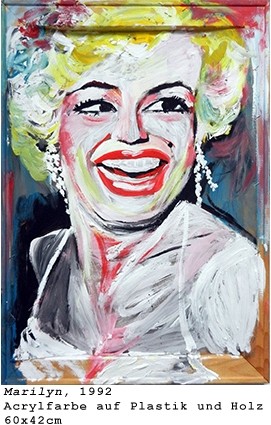Elke Silvia Krystufek
01 Nov - 20 Dec 2014
ELKE SILVIA KRYSTUFEK
Harmony 32
1 November - 20 December 2014
In December 2009, Elke Krystufek established the Elke Silvia Krystufek Archive, the second largest private collection in Austria, from which she has since been curating exhibitions. In her current work, she also deals intensively with other archives, intellectual property rights, and the public presentation of works of art. For the exhibition HARMONIE 19 this year at Galerie Meyer Kainer in Vienna, she created new work on the Arab subject of veiling. The work was based on photographs by Cindy Sherman, which Elke Silvia Krystufek documented in the collections of Meyer Kainer and Verbund in Austria and then transposed into drawings and paintings.
For the exhibition HARMONY 32, she takes as her source the folders containing Nicola von Senger's photo archives, which include images not only of artists and private life, but also paparazzi pictures of celebrities. This gave rise to the idea of curating an exhibition from the Elke Silvia Krystufek archive on the theme of "blond." Since first appearing in public, blonde icons such as Marilyn Monroe and Edie Sedgwick have become permanent fixtures of Western imagery, both as style icons and as integral figures for several generations of artwork. Prominent individuals less known for their "blondness," such as Hilary Clinton, Virginia Woolf, Elizabeth Peyton, and the British painter Duncan Grant, expand upon a clichéd image that commonly links success to external characteristics. A photograph of a newspaper article from 1999 showing the singer Heino, who is once again in the media thanks to his appearance with Rammstein and as a new judge for German reality talent show Deutschland sucht den Superstar, amusingly demonstrates how past and present fame among both the living and dead are reshuffled in the exhibition.
Elke Krystufek was already undermining the prevailing magazine aesthetics 10 years ago in her 2004 artist's book THE RICH VISIT THE POOR THE POOR VISIT THE RICH, from which the collage depicting Elizabeth Peyton is taken. The advertisements that appear in the book were between 15 and 20 years old at the time of publication – some of the products were no longer available, and the visual aesthetics were oddly austere in comparison to later luxuriant advertising created with Photoshop. Thanks to the rich trove of works she has accumulated since 1985, in her work Elke Silvia Krystufek can always counter the current high rate of art production and consumption with a historical reading. Building upon Marcel Duchamp's Le boîte en valise, the atlases of Aby Warburg and Gerhard Richter, as well as the feminist approach to the atlas theme in Griselda Pollock's Encounters in the Virtual Feminist Museum: Time, Space and the Archive, the Elke Silvia Krystufek Archive is both an artwork in its own right, as well as a method of working.
Text: Elke Silvia Krystufek Archive
Harmony 32
1 November - 20 December 2014
In December 2009, Elke Krystufek established the Elke Silvia Krystufek Archive, the second largest private collection in Austria, from which she has since been curating exhibitions. In her current work, she also deals intensively with other archives, intellectual property rights, and the public presentation of works of art. For the exhibition HARMONIE 19 this year at Galerie Meyer Kainer in Vienna, she created new work on the Arab subject of veiling. The work was based on photographs by Cindy Sherman, which Elke Silvia Krystufek documented in the collections of Meyer Kainer and Verbund in Austria and then transposed into drawings and paintings.
For the exhibition HARMONY 32, she takes as her source the folders containing Nicola von Senger's photo archives, which include images not only of artists and private life, but also paparazzi pictures of celebrities. This gave rise to the idea of curating an exhibition from the Elke Silvia Krystufek archive on the theme of "blond." Since first appearing in public, blonde icons such as Marilyn Monroe and Edie Sedgwick have become permanent fixtures of Western imagery, both as style icons and as integral figures for several generations of artwork. Prominent individuals less known for their "blondness," such as Hilary Clinton, Virginia Woolf, Elizabeth Peyton, and the British painter Duncan Grant, expand upon a clichéd image that commonly links success to external characteristics. A photograph of a newspaper article from 1999 showing the singer Heino, who is once again in the media thanks to his appearance with Rammstein and as a new judge for German reality talent show Deutschland sucht den Superstar, amusingly demonstrates how past and present fame among both the living and dead are reshuffled in the exhibition.
Elke Krystufek was already undermining the prevailing magazine aesthetics 10 years ago in her 2004 artist's book THE RICH VISIT THE POOR THE POOR VISIT THE RICH, from which the collage depicting Elizabeth Peyton is taken. The advertisements that appear in the book were between 15 and 20 years old at the time of publication – some of the products were no longer available, and the visual aesthetics were oddly austere in comparison to later luxuriant advertising created with Photoshop. Thanks to the rich trove of works she has accumulated since 1985, in her work Elke Silvia Krystufek can always counter the current high rate of art production and consumption with a historical reading. Building upon Marcel Duchamp's Le boîte en valise, the atlases of Aby Warburg and Gerhard Richter, as well as the feminist approach to the atlas theme in Griselda Pollock's Encounters in the Virtual Feminist Museum: Time, Space and the Archive, the Elke Silvia Krystufek Archive is both an artwork in its own right, as well as a method of working.
Text: Elke Silvia Krystufek Archive

